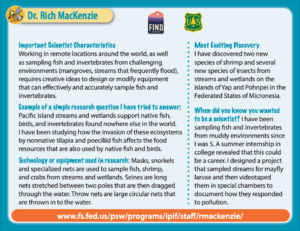Water


Gary Bentrup, Research Landscape Planner

- Master of Landscape Architecture, Utah State University
- USDA Forest Service Scientist
- I study agroforestry. Agroforestry is the use of trees to provide multiple benefits to society.
- Master of Landscape Architecture, Utah State University
- USDA Forest Service Scientist
- I study agroforestry. Agroforestry is the use of trees to provide multiple benefits to society.


Julie A. Arnold, Forestry Technician

- B.S., Clemson University
- USDA Forest Service Scientist
- As a forestry technician in the research field, my work is a balance of field work (i.e., collecting samples, taking measurements, and downloading dataloggers), lab work (i.e., sample preparation and analysis), and data processing (i.e., creating spreadsheets, charts, and graphs).
- B.S., Clemson University
- USDA Forest Service Scientist
- As a forestry technician in the research field, my work is a balance of field work (i.e., collecting samples, taking measurements, and downloading dataloggers), lab work (i.e., sample preparation and analysis), and data processing (i.e., creating spreadsheets, charts, and graphs).


Claudia Cotton, Forest Soil Scientist

- Ph.D., Virginia Tech
- USDA Forest Service Scientist
- Forest soil scientists observe, measure, and analyze forest soils. We do this to make sure that forest management activities, such as trail building and timber harvesting, do not negatively affect the forest soil.
- Ph.D., Virginia Tech
- USDA Forest Service Scientist
- Forest soil scientists observe, measure, and analyze forest soils. We do this to make sure that forest management activities, such as trail building and timber harvesting, do not negatively affect the forest soil.


Ge Sun, Hydrologist

- Ph.D., University of Florida
- USDA Forest Service Scientist
- Hydrologists study the water cycle. Studying the water cycle means tracking water movement from raindrops falling from sky to the ground, going into the soils, flowing through the rivers, and eventually moving to the ocean.
- Ph.D., University of Florida
- USDA Forest Service Scientist
- Hydrologists study the water cycle. Studying the water cycle means tracking water movement from raindrops falling from sky to the ground, going into the soils, flowing through the rivers, and eventually moving to the ocean.


Tamara Heartsill Scalley, Ecologist

- Ph.D., Utah State University
- USDA Forest Service Scientist
- An ecologist studies the dynamics and interactions between the environment and its organisms. I conduct research on tropical forests, watersheds, and streams.
- Ph.D., Utah State University
- USDA Forest Service Scientist
- An ecologist studies the dynamics and interactions between the environment and its organisms. I conduct research on tropical forests, watersheds, and streams.


Dan Neary, Soil Scientist & Hydrologist

- Ph.D., Michigan State University
- USDA Forest Service Scientist
- A soil scientist studies the physical, chemical, and biological aspects of soils, how they are classified, how they function, and how water moves through them. A hydrologist studies all the aspects of the quantity and quality of water cycle from precipitation to streamflow to groundwater.
- Ph.D., Michigan State University
- USDA Forest Service Scientist
- A soil scientist studies the physical, chemical, and biological aspects of soils, how they are classified, how they function, and how water moves through them. A hydrologist studies all the aspects of the quantity and quality of water cycle from precipitation to streamflow to groundwater.


Dr. Rich MacKenzie, Aquatic Ecologist

- University of Wisconsin at Milwaukee
- USDA Forest Service Scientist
- An aquatic ecologist studies plants and animals that live in streams, lakes, and wetlands. We try to understand the roles these organisms play in aquatic ecosystems and how stressors such as land use change, climate change, and exotic species influence those roles.
- University of Wisconsin at Milwaukee
- USDA Forest Service Scientist
- An aquatic ecologist studies plants and animals that live in streams, lakes, and wetlands. We try to understand the roles these organisms play in aquatic ecosystems and how stressors such as land use change, climate change, and exotic species influence those roles.


Charles Luce, Hydrologist

- Ph.D., Utah State University
- USDA Forest Service Scientist
- Hydrologists study how water moves around the world, whether as streamflow, groundwater, precipitation, or transpiration. Water is important to all life.
- Ph.D., Utah State University
- USDA Forest Service Scientist
- Hydrologists study how water moves around the world, whether as streamflow, groundwater, precipitation, or transpiration. Water is important to all life.


Jonathan Long, Ecologist

- Ph.D., Northern Arizona University
- USDA Forest Service Scientist
- I seek to understand how different parts of an ecosystem, such as plants, rocks, water, and human uses, interact and change. My research strives to help people take care of their environment, especially after damaging events.
- Ph.D., Northern Arizona University
- USDA Forest Service Scientist
- I seek to understand how different parts of an ecosystem, such as plants, rocks, water, and human uses, interact and change. My research strives to help people take care of their environment, especially after damaging events.


Stephanie Laseter, Hydrologist

- M.S., University of Georgia
- USDA Forest Service Scientist
- A forest hydrologist studies the water cycle. Where does water go after it falls as a raindrop? We study how it travels through a forest, into the soil, and eventually to a stream.
- M.S., University of Georgia
- USDA Forest Service Scientist
- A forest hydrologist studies the water cycle. Where does water go after it falls as a raindrop? We study how it travels through a forest, into the soil, and eventually to a stream.



















